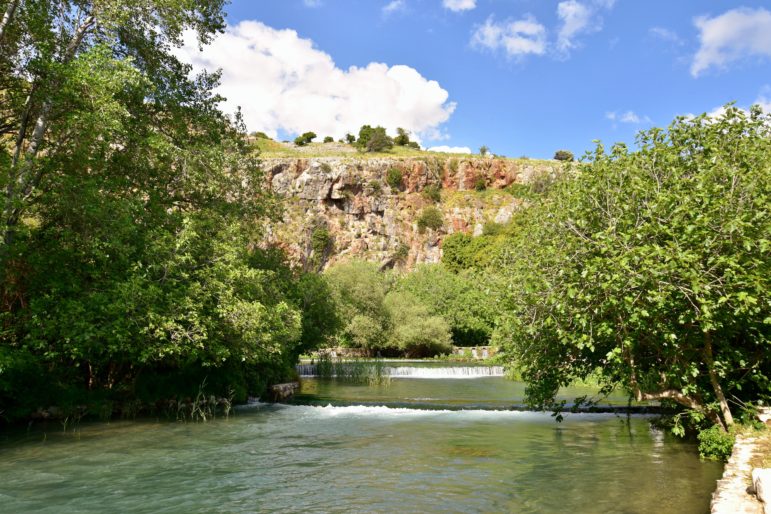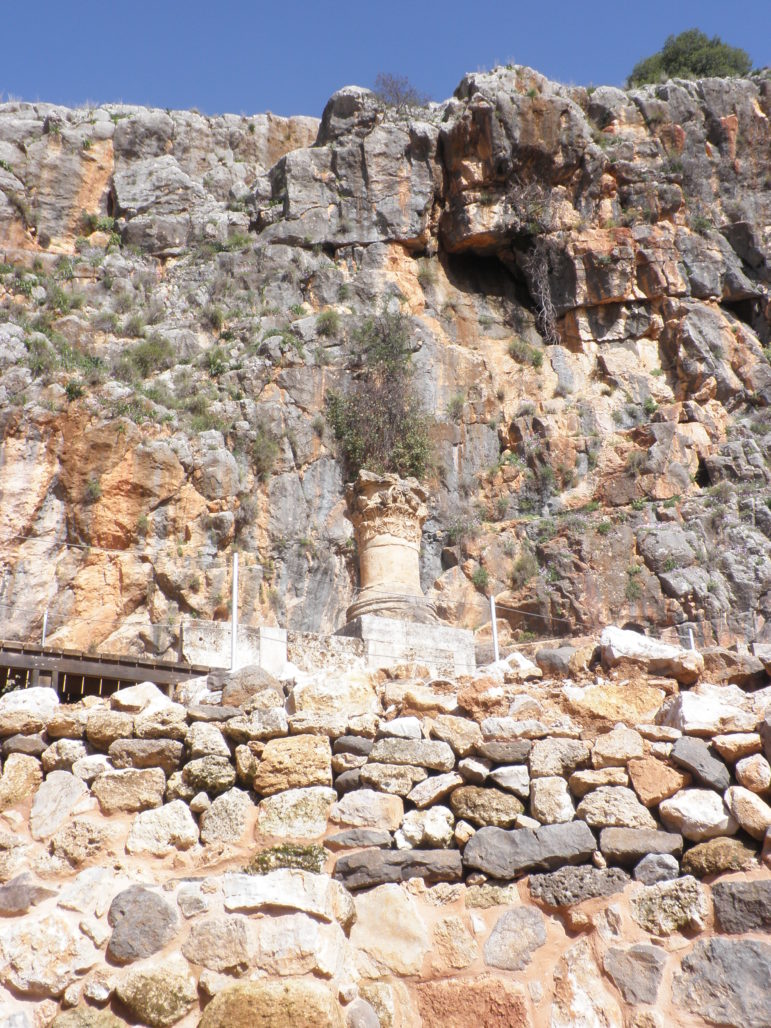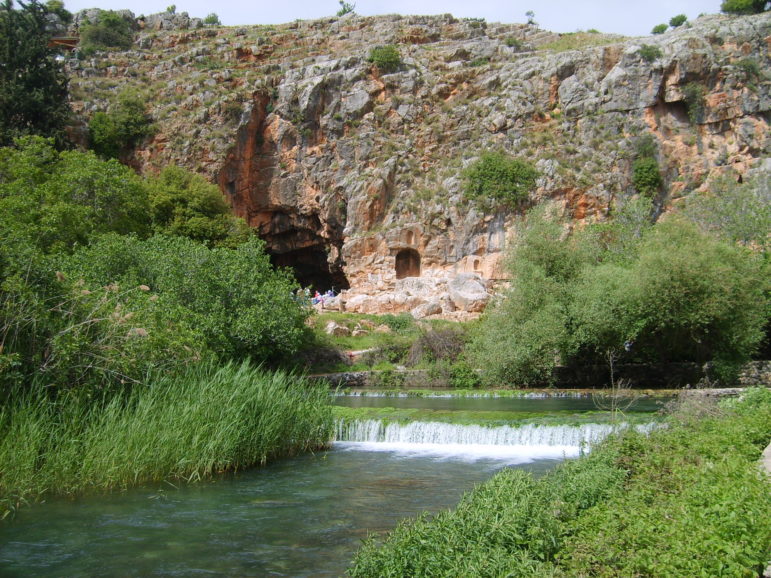TWH – Israeli researchers have discovered a temple to Pan in a recently excavated Byzantine church in the Banias Nature Reserve near the northeastern border with Lebanon. The area is also called the Nahal Hermon Nature Reserve.

View of the Nahal Hermon (Hermon Stream), looking towards its spring at Banias – Image credit: Bahnfrend – CC BY-SA 4.0
The latest in a series of Byzantine era churches holds a new mystery about the god Pan in the region.
Previous discoveries of Byzantine churches have yielded interesting finds. For example, a 1,500-year-old Byzantine church found two years ago near Jerusalem contained inscriptions in Greek that one historian, Jacob Ashkenazi who co-directs the research project, noted were in small towns that were populated by Semitic pagans.
A related find underscores the involvement of women in the church building projects. One named donor, Sausann, is named in a mosaic identifying who supported church construction. It suggests that women had the necessary financial and political resources to participate in sponsoring such ventures.
The current archeological find, which was announced in phases over the last month, adds to the intrigue of some ancient churches in the Levant.
The researchers found a partial mosaic floor and undressed stones with cross marks suggesting the location as a pilgrimage site for the worship of Jesus. The cross marks became a common symbol for Christian worshippers to leave behind after the reign of Roman Emperor Constantine. His reign ended in 337 CE.

Other ruins at Banias Springs – Image credit: Qasinka – CC BY-SA 3.0
Professor Adi Erlich, a researcher at the University of Haifa’s Zinman Institute of Archaeology, told the Jerusalem Post that the mosaic at the Bainas site confirms the building’s use as a church.
However, during the excavation, the researchers found niches and altars suggesting the site was likely unroofed. A small pool was also found in the center of the church compound.
The researchers then came upon an inscription dedicating the site to Pan. The inscription, being studied at Bar-Ilan University, reads in Greek: “Atheneon son of Sosipatros of Antioch is dedicating the altar to the god Pan Heliopolitanus. He built the altar using his own personal money in fulfillment of a vow he made.”
Ehrlich noted that the carving’s reference to Antioch suggested that the site was associated with “pilgrims coming from afar.” The professor added that whoever wrote the inscription, “was no pro” since the letters shrink toward the end of the message suggesting the scribe started to run out of space.
The researchers note that there are two important aspects of the inscription.
First, they noted that “the combination of Pan with Heliopolitanus, a name normally associated with Zeus.” There is speculation that Pan Heliopolitanus may have been a deity with combined aspects Pan and Zeus, or possibly another name for the god of wild places.
However a major temple in the Baalbek, Lebanon – some 50 miles to the north of the Banias region – holds numerous Roman temples with a major one dedicated to Jupiter Optimus Maximus Heliopolitanus.
The second important aspect is that the origin of the donor is Antioch, some 250 miles (~400 km) north. Prof. Adi Erlich of the Zinman Institute of Archaeology, University of Haifa said, “It seems that this cult place was visited by pilgrims coming from afar.”
The altar was found horizontally, but it was unclear why. It was also made of basalt instead of the local limestone. The rock choice becomes important because basalt better preserves inscriptions than limestone. However, the motivations behind the choice is unknown.
The finding highlights how the lives and fifth-century Christians were entangled within the previous uses of the building. By 320 CE the site had a Christian bishop, but it is unclear if the site remained a location for other faiths.
The location itself is also important.
Ehrlich explained, “The temple to the god Pan and the church were discovered in a topographic environment that combines a cliff, a cave, springs and a terrace created in ancient times from the collapse of part of the cliff, which is where the temples were built. The god Pan was worshiped near the cave and the spring, hence the origin of the name of the ancient city Phenias which later changed to Banias.”
It is unclear how long this specific temple to Pan pre-dated the Christian era. However, the Banias region was well known during the Hellenic period as a site dedicated to Pan. There is a spring associated with the god and the nearby waterfalls. Archeologists have uncovered shrines dedicated to Pan and other gods dating back, at least, to its conquest by Alexander the Great.
The area was then known as Panion and Pliny the Elder called the city Paneas. The spring of Banias contains a series of shrines carved directly from the nearby cliff-face. At least one inscription relates to Pan and Echo, the Oread nymph whose story is recounted in Ovid’s Metamorphoses.

Pan’s cave and Nahal Hermon at Banias Springs – Image credit: gugganij – CC BY-SA 3.0
Ehrlich added, “King Herod built a temple in the area to the Emperor Augustus in the late first century BCE… Throughout the Roman period, the city was an important center of worship for the gods Pan and Zeus.”
The site is also mentioned in the Gospels of Matthew and Mark by the name of Caesarea Philippi. According to the New Testament, it was Banias that Peter recognized Jesus as the Messiah, and Jesus gave him the keys of heaven. As such, it was an important destination of pilgrimage.
The findings show that Pan was worshipped at the site since before the time of Jesus through at least the fifth century and gradually passed to Christian dominance. Though ancient builders often repurposed sites and materials from older structures, Erlich notes that the altar’s repurposing as part of a wall may have been to intentionally humiliate the local worshippers of the “old” gods.
The Wild Hunt is not responsible for links to external content.
To join a conversation on this post:
Visit our The Wild Hunt subreddit! Point your favorite browser to https://www.reddit.com/r/The_Wild_Hunt_News/, then click “JOIN”. Make sure to click the bell, too, to be notified of new articles posted to our subreddit.